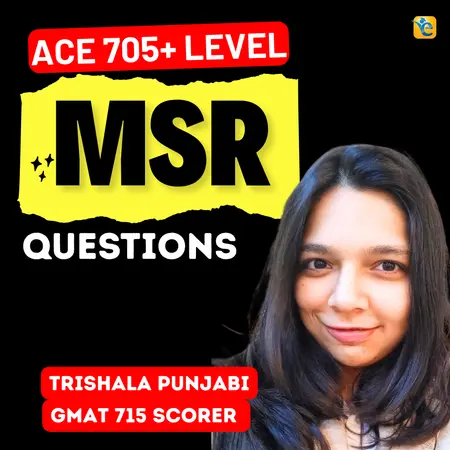Events & Promotions
|
|

GMAT Club Daily Prep
Thank you for using the timer - this advanced tool can estimate your performance and suggest more practice questions. We have subscribed you to Daily Prep Questions via email.
Customized
for You
Track
Your Progress
Practice
Pays
Not interested in getting valuable practice questions and articles delivered to your email? No problem, unsubscribe here.
- Nov 19
12:30 PM EST
-01:30 PM EST
Learn how Keshav, a Chartered Accountant, scored an impressive 705 on GMAT in just 30 days with GMATWhiz's expert guidance. In this video, he shares preparation tips and strategies that worked for him, including the mock, time management, and more - Nov 20
01:30 PM EST
-02:30 PM IST
Learn how Kamakshi achieved a GMAT 675 with an impressive 96th %ile in Data Insights. Discover the unique methods and exam strategies that helped her excel in DI along with other sections for a balanced and high score. - Nov 22
11:00 AM IST
-01:00 PM IST
Do RC/MSR passages scare you? e-GMAT is conducting a masterclass to help you learn – Learn effective reading strategies Tackle difficult RC & MSR with confidence Excel in timed test environment - Nov 23
11:00 AM IST
-01:00 PM IST
Attend this free GMAT Algebra Webinar and learn how to master the most challenging Inequalities and Absolute Value problems with ease. - Nov 24
07:00 PM PST
-08:00 PM PST
Full-length FE mock with insightful analytics, weakness diagnosis, and video explanations! - Nov 25
10:00 AM EST
-11:00 AM EST
Prefer video-based learning? The Target Test Prep OnDemand course is a one-of-a-kind video masterclass featuring 400 hours of lecture-style teaching by Scott Woodbury-Stewart, founder of Target Test Prep and one of the most accomplished GMAT instructors.
Kudos
Bookmarks
C
Be sure to select an answer first to save it in the Error Log before revealing the correct answer (OA)!
Difficulty:
 95%
(hard)
95%
(hard)
Question Stats:
38% (02:19) correct 62%
(02:06)
wrong
62%
(02:06)
wrong  based on 924
sessions
based on 924
sessions
History
Date
Time
Result
Not Attempted Yet
A Farey sequence of order n is the sequence of fractions between 0 and 1 which, when in lowest terms, have denominators less than or equal to n, arranged in order of increasing size. For example, the Farey sequence of order 3 is: {0, 1/3 , 1/2, 2/3 , 1}. Is sequence S a Farey sequence?
(1) Sequence S has fewer than 10 elements.
(2) The second element of sequence S is 1/5
(1) Sequence S has fewer than 10 elements.
(2) The second element of sequence S is 1/5
Kudos
Bookmarks
A Farey sequence of order n is the sequence of fractions between 0 and 1 which, when in lowest terms, have denominators less than or equal to n, arranged in order of increasing size. For example, the Farey sequence of order 3 is: {0, 1/3 , 1/2, 2/3 , 1}. Is sequence S a Farey sequence?
(1) Sequence S has fewer than 10 elements. Clearly insufficient, S can be any sequence.
(2) The second element of sequence S is 1/5 --> there is a Farey sequences with 1/5 as the second element in it as well as there are infinitely many other type of sequences also with 1/5 as the second element in it. Not sufficient.
(1)+(2) Now, in order 1/5 to be the second element of a Farey sequence, the sequence must be of order 5: {0⁄1, 1⁄5, 1⁄4, 1⁄3, 2⁄5, 1⁄2, 3⁄5, 2⁄3, 3⁄4, 4⁄5, 1⁄1}, which as we can see has 11 elements, so the sequence which has fewer than 10 elements and has the second element equal to 1/5 cannot be a Farey sequence. Sufficient.
Answer: C.
(1) Sequence S has fewer than 10 elements. Clearly insufficient, S can be any sequence.
(2) The second element of sequence S is 1/5 --> there is a Farey sequences with 1/5 as the second element in it as well as there are infinitely many other type of sequences also with 1/5 as the second element in it. Not sufficient.
(1)+(2) Now, in order 1/5 to be the second element of a Farey sequence, the sequence must be of order 5: {0⁄1, 1⁄5, 1⁄4, 1⁄3, 2⁄5, 1⁄2, 3⁄5, 2⁄3, 3⁄4, 4⁄5, 1⁄1}, which as we can see has 11 elements, so the sequence which has fewer than 10 elements and has the second element equal to 1/5 cannot be a Farey sequence. Sufficient.
Answer: C.
General Discussion
Kudos
Bookmarks
| A Farey sequence of order n is the sequence of fractions between 0 and 1 which, when in lowest terms, have denominators less than or equal to n, arranged in order of increasing size. For example, the Farey sequence of order 3 is: {0, 1/3 , 1/2, 2/3 , 1}. Is sequence S a Farey sequence? (1) Sequence S has fewer than 10 elements. (2) The second element of sequence S is 1/5 |
I've never seen a question like this...
(1) can be any sequence less than 10 elements - insufficient
(2) can be any sequence with 2nd term 1/5 - insufficient
Now combining both statements...
The only way to definitively answer is if the Farey sequence (0, 1/5 , .., ..., 1) doesnt fit the parameters given
so the Farey sequence is (0, 1/5, 1/4, 1/3, 2/5, 1/2, 3/5, 2/3, 3/4, 1)
Thus the farey sequence in question has 10 elements thus it cannot be the farey sequence so it is sufficient.















